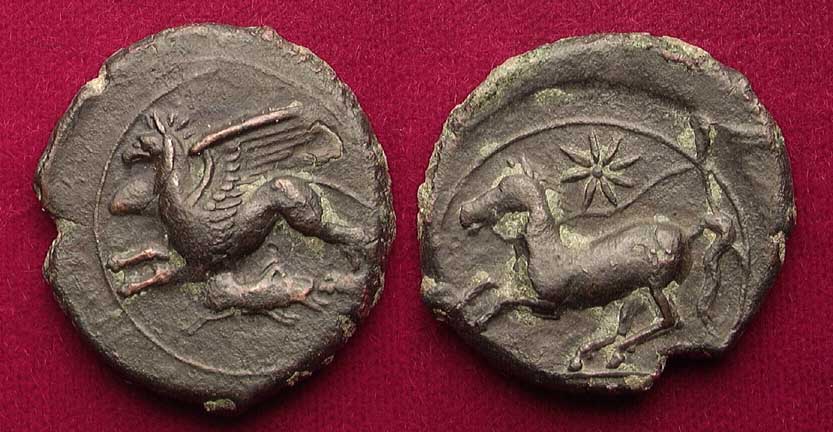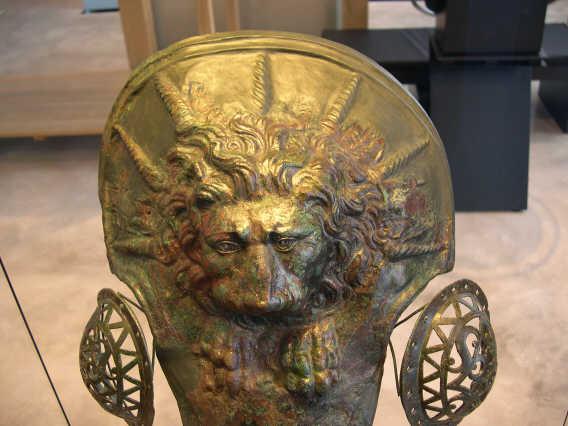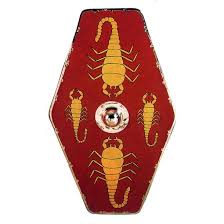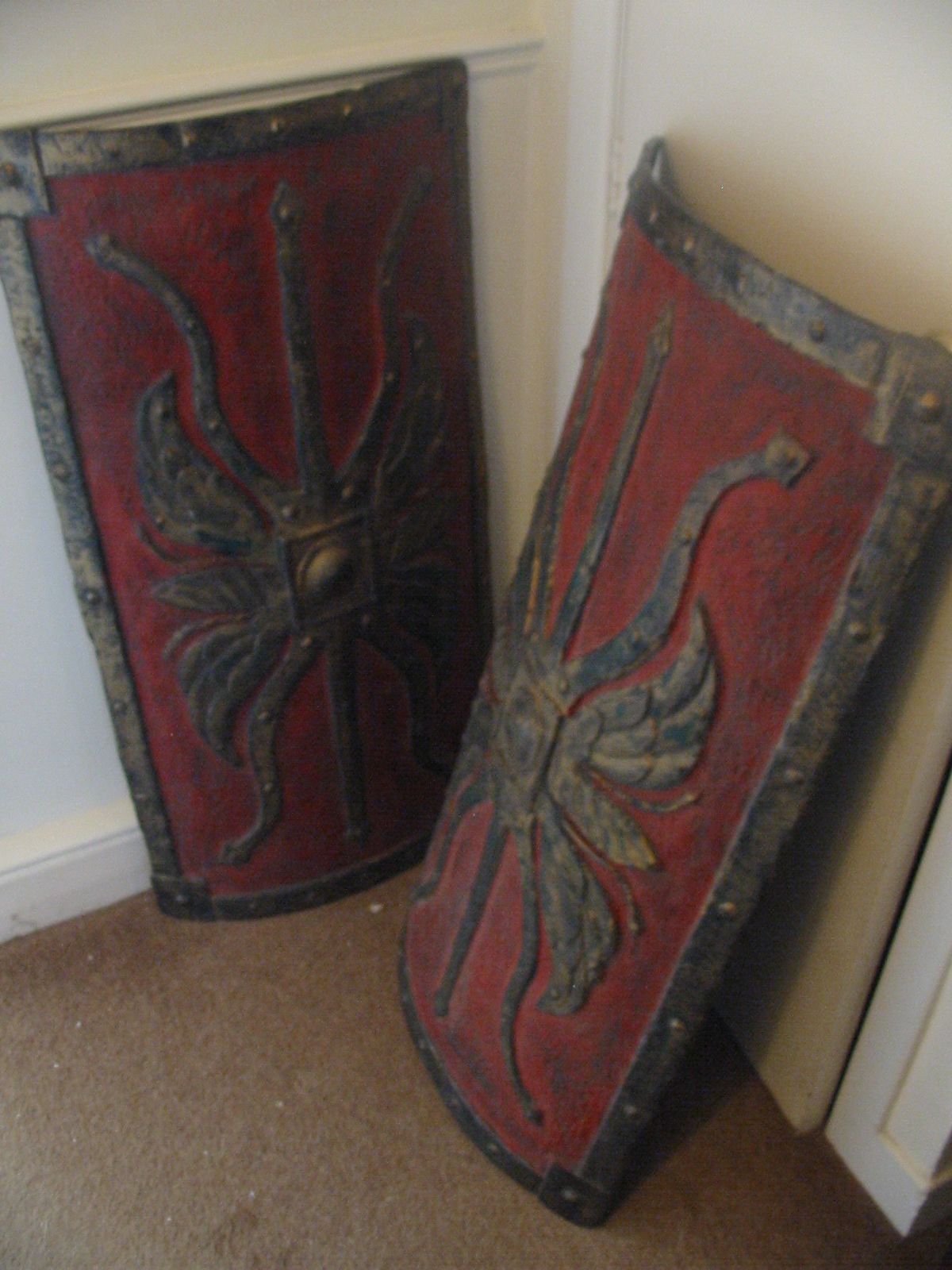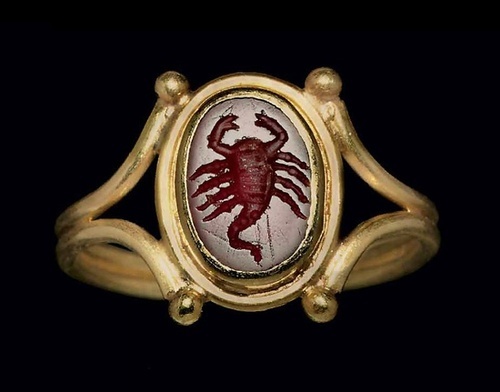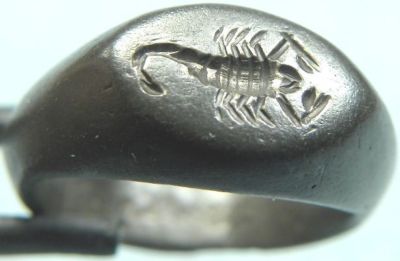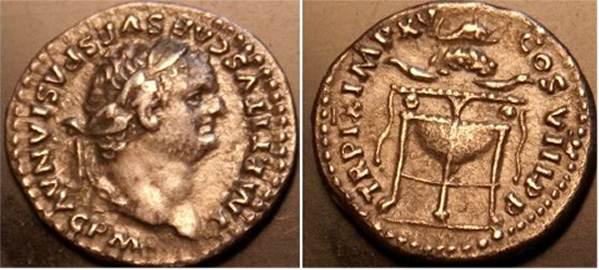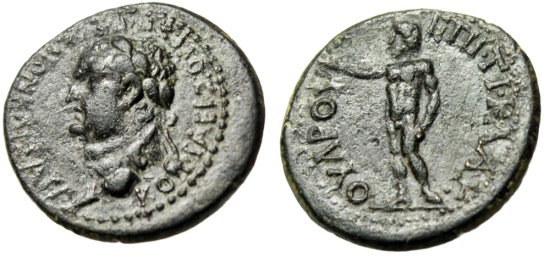Text
Revelation 9:1 So the fifth angel trumpeted, and I saw a ‘star’ that had fallen out of the sky to the earth. And to him was given the key to the shaft of the Abyss. 2 So he opened the shaft of the Abyss and smoke went up out of the shaft, like the smoke of a burning furnace; and the sun and the air were darkened because of the smoke from the shaft. 3 And ‘locusts’ exited from the smoke into the earth. And to them was given a capability just like the scorpions of the earth have capability. 4 And they were told not to harm the grass of the earth, nor any green plant, nor any tree, but only those men who do not have the seal of God on their foreheads. 5 And it was designated to them [locusts], not to kill them [men] but, to torment them five months. And their torment is like the torment of a scorpion whenever it strikes a person. 6 And in those days the people will seek death but not find it; they will want to die but death will run away from them.
7 Now the appearance of the ‘locusts’ was like horses prepared for battle, and something like a golden crown was on their heads, and their faces were like human faces. 8 They had hair like a woman’s and their teeth were like a lion’s. 9 They had breastplates like breastplates of iron and the noise of their wings was like the noise of many chariots with horses rushing into battle. 10 And, they have tails like scorpions and stingers precisely in those tails! They have the capability to hurt the populace five months, 11 having as king over them the angel of the Abyss—his name in Hebrew is Abbadon, while in Greek he has the name Apollyon.
12 The first woe is past, but, two woes are still coming, after these things.1
Introduction
Symbolic, literal, what?
Negative clues
This is a passage that has been terribly tortured by Premils, Amils, Postmils, Full Preterists and even by our own camp, the Postmillennial Partial Preterists. Some err on the side of seeing nothing whatsoever symbolic in the passage. Others err in the opposite direction of seeing it as a symbol of a symbol of something else. But almost all of them completely ignore the time sequence that we have been carefully documenting. They take these trumpets out of order.
So what I am going to do today is to lay the groundwork for when this happened and what on earth it is talking about - at least in general terms. Then next week I will start getting into the specifics of demonology because that is the main purpose for this chapter. It is designed to teach us more about the enemy that we must all engage. But first of all, let me try to slice through the viewpoints out there by giving one sample interpretation from each of two extremes.
First of all, the non-symbolic approach. In one sermon I poked fun at Hal Lindsey for saying that these locusts reminded him of cobra helicopters. But let me give you a different (and perhaps for some people a much more convincing) Dispensationalist interpretation.2 And keep in mind that even though I strongly disagree with these Dispensationalists, they are good Christian brothers in the Lord. I love them. But they are wrong. This view takes this passage as literally as possible and ends up admitting that there is probably some demonic behind the scenes, but that the passage is primarily talking about literal bio-engineered locusts. Not all Dispensationalists hold to that, but it is a popular viewpoint.
Here is their exegesis: The second phrase in verse 1 says, "and I saw a ‘star’ that had fallen out of the sky to the earth..." The claim is that to first century John, a nuclear bomb falling out of the sky would look like a falling star or a meteorite. The next sentence says, "And to him was given the key to the shaft of the Abyss." The driver of the aircraft that will drop this supposedly future bomb is going to send many people to their death, so in a sense he was opening hell to millions of souls.
Verse 2 says, "So he opened the shaft of the Abyss." The claim is that this dropping of a nuclear bomb metaphorically is being described as all hell breaking loose. You will notice that he is not literal on that part of the interpretation. He can't be and still maintain literal locusts. Verse 2 continues, "and smoke went up out of the shaft, like the smoke of a burning furnace; and the sun and the air were darkened because of the smoke from the shaft." This then would be the resulting mushroom cloud from a nuclear detonation.
Verse 3: "And ‘locusts’ exited from the smoke into the earth. And to them was given a capability just like the scorpions of the earth have capability." They say that this will either be random genetic mutation of locusts as a result of nuclear radiation on the outskirts of the blast (and thus their coming out of the cloud), or (because it says "to them was given a capability") it might be a deliberate genetic modification by scientists. Those who think it will be a deliberate modification through gene splicing point to the fact that these locusts seem to have genes from locusts, scorpions, and other creatures. Well, it doesn't say that there are spliced genes, but that's the only way you can explain this, right? It's "obvious." So the purpose statement in the grammar is attributed to the scientists who gave this new terrifying biological weapon its capabilities.
Verse 4: "And they were told not to harm the grass of the earth, nor any green plant, nor any tree, but only those men who do not have the seal of God on their foreheads." Since locusts normally eat green plants, and since these don't, there must have been a major genetic modification going on, right? That much is "clear." These locusts only seem interested in human flesh. And to those who object that locusts couldn't possibly know the difference between unbelievers and those who are sealed by God, they respond, "Oh, that's easy. The ones who had been sealed by God had already been raptured out of the earth in a mid-trib rapture, so the locusts can only touch unbelievers because there won't be anything but unbelievers on the earth." That's pretty obvious so far, right? And when the unbelievers are hurt by these genetically modified insects they will experience such pain and suffering that they will wish that they were dead. It is the ultimate biological weapon.
They say that verses 7-10 give a description of these genetically modified locusts and show that they have genes from quite a number of creatures, including humans, lions, horses, and scorpions. When verse 11 says that these locusts have a king over them, it is either referring to Satan's power over the scientists who produced this weapon (the viewpoint of some) or it is referring to the head scientist or messenger of the king who ordered these biological weapons (since the Greek term angelos can refer to a human messenger).
So there you have it - a supposedly literal interpretation that avoids the confusion and subjectivity that is rife in the Historicist interpretations. I know you already feel much better. We've got this chapter covered, right?
The problem is, this interpretation violates the chronology of this passage, which forces us to some time in the Fall of AD 66. Second, it isn't as literal as it claims to be. My interpretation is actually much more literal. The star is called a "him." What stars are called "him" in the Bible? Either angels or elders. Well, this "him" is given a key to a literal Abyss, which elsewhere is called hell. So we would expect that this "him" is an angel. And indeed, angels are called stars in Job.
But this passage is not just metaphorically saying that hell breaks loose. Hell is literally opened up and numerous demons that had been previously bound there are released.
And furthermore, there is no mention of a rapture of those with the seal on their foreheads. Instead, the 144,000 who were sealed on their foreheads in chapter 7 are still alive in chapter 14. And verse 4 certainly implies that they are still alive in this chapter.
Furthermore, the king of these locusts is not a scientist or a human ruler. Verse 11 explicitly calls him an angel of the Abyss. What kind of angels are in the Abyss? Not scientists - well, a lot of scientists probably will head there. But an angel of the Abyss would be a fallen angel, or a demon. And this appears to have been a particularly dangerous demonic king who is let loose by Satan. Now, if a fallen angel is the king of the Abyss, and the king of the locusts, it is more natural to take the locusts as demons as well.
Furthermore, Abbadon is the name of a destructive demon consigned to the pit in the Old Testament (Hebrew of Job 26:6; 28:22; Prov. 15:11 and Ps. 88:12), and the Greek Septuagint that was available in the first century translates that Hebrew name with Apollon, from which we get the English Apollyon.
And even their view that this takes place in the future does not take the text literally. We already saw that the fourth trumpet ended on October 15 of AD 66. But notice the second half of chapter 8, verse 12. It pronounced woes "because of the remaining blasts of the trumpet of the three angels who are about to sound." They were about to sound on October 15 of AD 66, and on my interpretation they do so.
So this is not as literal an interpretation as people make it out to be. A literalist should take these creatures as demons, not genetically modified insects. What kind of an insect can live for five months without eating? And they don't eat human flesh because the humans afflicted by these locusts don't die yet.
But on the opposite side of the spectrum are the Historicists in the Premil, Amil, and Postmil camps who admit that the locusts are a symbol of something demonic (so far so good; I totally agree), but they go on to say that the demonic is a symbol of the Muslim invasions of Christendom in the seventh century (not so good). And the reason this violates rules of interpretation is that you have a symbol of a symbol. For them the locust is a symbol of demons, and the demons in turn become symbols of the Muslims. But that is taking symbology too far. Biblical symbols always have a correspondence to something literal. They are not going to symbolize another symbol that symbolizes something real. A symbol is always going to symbolize something real or literal - not yet another symbol.
Now, the Historicists also ignore the chronology that we have given. But my main hermeneutical problem with their approach is that there is no necessary connection between the original symbol and what the commentator says that the symbol means. And this too leads to squishy subjectivity. And when you see all the interpretations given by Historicists, you can see how squishy and subjective it really is. Early Historicists saw these demonic locusts as symbolizing the Roman Catholic Benedictine orders that arose in AD 530, and when that didn't work they applied it to the Muslims in the seventh century. Well that seems quite different. But it gets worse. The timing didn't seem to be right with the Muslims, so others applied it to the Dominican orders in the 1200s, and others to the Jesuits after the 1500s. And some Roman Catholics returned the favor and applied it to the Lutherans. But on their approach there is nothing in the text itself that would give you a clue as to which people the symbol of the symbol symbolized. It's a faulty approach.
In chapter 1:1 we saw that John had warned us that he was going to be talking about literal historical events that were about to happen, but using symbols to communicate to us about those literal events. So what is the symbol and what is the literal event?
Is this a literal locust plague that symbolizes demons? That would be a plausible theory if it were not for the fact that several things in the text argue against it. The first is that our timing is shortly after October 15, and locust plagues don't come out until the Spring time. So that is the first clue that he is probably not talking about literal locusts plagues. The second clue is that these locusts don't eat any green plants, and that is all that literal locusts eat. Thirdly, Proverbs 30:27 says that literal locusts don't have a king, yet the locusts in verse 11 have a king over them, and the king's name is destroyer - in Hebrew Abaddon and in Greek, Apollyon. And there are other indicators in the text that this can't be a literal plague of insects. That would have been the simplest explanation, but it just doesn't work.
So what other symbol is an option? And the answer is that Titus' army was filled with symbols that directly pointed to these demonic beings. They worshiped these beings and prayed that these demons would give them victory. That's why they used the symbols - to honor the Roman gods, that we would call "demons." In fact, every shield that they carried and every standard that led the way had these symbols on them. The symbols in Titus' army that he brought up from Egypt are addressed in verses 1-12, and the demonic symbols in Vespasian's army perfectly point to and describe the demons at the Euphrates River in verses 13-21.
You see, as soon as the previous Legate of Syria (and a legate is kind of like a governor of a region, but also the head of an army), Cestius Gallus, was defeated on October 15, a messenger was sent to Nero. That took about 16 days, and since these demons are later said to have ushered forth from the Beast's mouth, the unleashing of these demons had to have taken place around October 31 when Nero authorized Vespasian and his son Titus to fight against Israel. And that perfectly meshes with all of the other timing features that we have from the secular histories, including the amount of time it took Titus to reach Alexandria and bring the troops to Israel. My calculations of all of the timing indicators in Josephus indicate that Titus' armies did not start killing in Israel for five months. When I worked my calculations forwards it was 150 days, or exactly five lunar months of 30 days. When I worked the calculations backwards from a different date, it came to 153 days, or just three days over five lunar months, which would be five solar months. We have less information working backwards. But either way it is five months.
So in terms of timing, the defeat of Cestius took place on October 15. Then the last part of Revelation 8:13 says that on that date (on October 15) the other angels are about to sound. Well, 16 days later is very imminent. And the first angel does sound. It sounds on October 31, or 16 days later - as soon as Nero received the message. So if you have been marking dates in your Bibles, verse 1 is Dius 24 or October 31.
So the chronology of chapters 5-11 really does mesh perfectly. Lord willing, I will give you a lesson on demonology next week, but today let me demonstrate the tight connection between the symbols in Titus' armies and this horde of demons. We have several clues. I'm just going to give the key ones.
Postive clues
Abyss (NKJV = bottomless pit; Greek = ἄβυσσος). This is used of both ocean (Gen. 1:2; 7:11; etc; Ps. 77:16; 106:9; Is. 44:27; 63:13; etc.) and hell (Ezek. 31:15; Amos 7:4; Ps. 71:20; Luke 8:31; Rev. 9:1,11; 11:7; 17:8; 20:1,3)
First, these locusts are said to come out of the Abyss. There is a play on words here. The Greek word abussos can refer to either the Mediterranean Ocean (and I've given you several verses on that) or it can refer to hell itself (and I've given you some Scriptures on that). So, since the word "abyss" can refer to either, the Fifteenth Legion from Egypt could come by way of the Sea while the demons that were symbolized would literally be unleashed from hell. So while the symbols are coming from an abussos, the literal demons that are symbolized also come from an *abussos."
As we will see in a bit, they had Apollyon as their patron god, and called upon Appolyon's forces to aid them in destruction. And the language that John uses is so amazing in how perfectly it accounts for both the symbol and the thing symbolized.
locusts
Most importantly, the mascot or emblem of the Fifteenth Legion that Titus brought from Alexandria3 was the locust. This was because the locust was sacred to Apollo, the god of destruction, who was the patron god of that legion. That Legio was called Apollonaris or lover of Apollo. In Athens there is a statue of Apollo with the name, Apollo Parnopios, or Apollo of the locusts.4 Apollo was the god of war and of destruction. And what an appropriate name that was for Titus' legion.
In any case, not only did the Fifteenth Legion wear the emblem of the locust, their armor in many ways looked like the thorax of a locust. So the shields looked like locusts and the armor looked like locusts. And historians make references to Titus' soldiers being called an army of locusts. For example, Hegessippus says that they ravaged the land like locusts. When the Book of Hermas speaks of the troops that invaded Israel under Titus, it referred to them as fiery locusts coming out of the mouth of the Beast, or Rome. Here they are coming out of something fiery as well. Hermas says,
Behold I see a great Beast... and out of its mouth fiery locusts went forth. This beast came out so fiercely, as if it could demolish the city at a blow... This Beast is the emblem of the wrath about to come. (Hermas, Vision 4).
He identified the Beast as the demon in charge of Rome and the locusts as coming out of the mouth of the beast, or in other words, being authorized by that head demon. Likewise, the Babylonian Talmud speaks of Titus's invasion with his Legion as “The destruction of Jerusalem ... through locusts and through the son of a locust.”5 So they refer to Titus as the son of a locust and they refer to his armies as locusts. Well, Vespasian used to be the commander of the Fifteenth Legion, and if he was its head locust, it is also true that Titus was the son of a locust and led those locust armies to destroy Jerusalem.
And this would have been instantaneously obvious to anyone who had witnessed these Roman armies coming into Israel. We are always asking the question, "What would the original audience have thought?" And they would have thought that this was the locust plague in symbolic form. Just imagine tens of thousands of infantry with shields bearing the image of a locust and thousands of cavalry with shields bearing the images of scorpions, and horses with lion's head armor, and standard bearers who wore the lion pelt with the teeth of the lion being exposed. And I will get to the long hair and some of the other imagery in a bit.
But the point is that the descriptions of these locusts have so many parallels with the Roman army of Titus that several commentaries are content to say that the only thing that this chapter is referring to is the Roman soldiers. But that would be to confuse the sign and the thing symbolized. The symbol that came was the emblems of the Roman army (that's true), but the main and the most fearful enemies that their symbolism was clearly pointing to was the demon Apollyon and his demonic locust spirits. It is important that we not confuse the symbol for the thing symbolized. In this case God is emphasizing the demonic hordes that are converging on the land of Israel - and actually rushing ahead of Titus' army to prepare the way for it. They will probably fly to Israel and torment the people there five months before Titus' army is able to arrive. But let's fill out the symbolism in Titus' army a bit more.
the composite shape of the locusts (vv. 7-10)
When you keep reading in verses 7-10 you see that these locusts had a description that amounts to a composite listing of features from several creatures - a scorpion, a horse, a woman, and a lion. What is with that? Well, those were the emblems of the parts of various Legions and cavalries that played a supporting role to the Fifteenth Legion. The Fifteenth Legion's mascot was a locust, but the other legions had their own mascots, usually taken from one of the signs of the Zodiac.
The two signs of the Second Legion were the scorpion and the Capricorn, both of which resemble some of the descriptions in this passage. The emblem of the Tenth Legion was a horse and a boar. Well, we don't have anything that looks like a boar, but we do have things that have a resemblance to horses. The Fifteenth Legion had a locust and a griffin, and the griffin had mixed elements of a lion and an eagle. To date, no one has discovered the emblem of the Twenty-Second Legion, but every legion had a Roman god and a demonic animal-like symbol associated with it. So the composite description here is a perfect composite of the demonic emblems of the armies that accompanied Titus' Fifteenth Legion, Apollonaris.
What about the long hair like women? That too could be a reference to the Zodiac symbol of Virgo or the Virgin. In early Rome that constellation was often called "Coma Berenices," or "Berenice's hair." And some commentators believe that is the reference to long hair like a woman's hair. But others attribute it to the long horse hair that the Romans placed on top of their helmets. Sometimes the hair was standing straight up, and in other engravings it comes down their back and was braided like a woman's braided hair. So that is a second possibility. The third possibility is that this could refer to Titus' light cavalry, who were the Mauri horsemen. These incredibly fast attack cavalry were almost always pictured with very long hair.6 Chilton points out that the demonic armies in the Old Testament have a word for demon that literally means "hairy one" (Jer. 51:27; Joel 1:6; 2:4-10; cf. Lev. 17:7; 2 Chron. 11:15).7 Or John could have been referring to a combination of those four. I'm not certain, and won't be dogmatic. Now, next week I will comment on how demons try to bring confusion to God's natural order, and homosexuality is one of the ways that they do so. Quite a number of commentaries see the demonic impulse behind homosexuality and the Transgender movement in these symbols. I won't get into that today.
But the composite shape of the locusts appears to many commentators to be the symbolism attached to Titus' infantry and cavalry that he brought up from Egypt. If that is the case (which I am totally convinced that it is), then those symbols pointed to the literal demonic forces that were behind Titus' army in the first 12 verses. And the symbols in verses 13-21 are the demonic totems and symbols that pointed to and called upon the literal demonic forces that were behind Vespasian's armies in verses 13-21.
Abaddon/Apollyon
And the demonic prince in the first half of the chapter is described in verse 11. It says,
... having as king over them the angel of the Abyss — his name in Hebrew is Abbadon, while in Greek he has the name Apollyon.
I believe the evidence points to the fact that he was such a dangerous demon that he had been previously bound in the pit. Yet Jesus allowed him to be released by Satan. Unleashing demons upon humans is a part of Christ's judgments on nations. It's one of the reasons our nation has become so demonized.
But back to this demon - this is the demon that possessed Titus, and who gave Titus demonic powers. At some point I will probably share some of the unbelievably demonic things that Titus did. But his father, Vespasian, had some of the same demonic powers. He became the new Legate in Syria (he replaced Cestius) and he headed up all the armies in Israel. So there is another demon who takes over Vespasian's life in the second half of this chapter.
But all of that is to say that there really is a tight connection between the human rulers with armies and the demonic rulers with armies. And it has always been the case. It is one of the reasons why Christians need prayer cover from their churches when they join the military. And during time of war there is so much irrational demonic stuff that happens. The perverted things that went on by Americans against Muslim prisoners is demonic. And we might touch on that next week.
But back to the symbols, it is interesting that the coins and the histories show both Vespasian and Titus being pictured and being described by these demonic powers in glowing terms. The Romans thought it was great - the supernatural powers proved the favor of the gods upon Vespasian and his son, Titus. We realize that those gods were actually very vicious and very ugly demons. In any case, Vespasian was acclaimed as Zeus while he is still in Israel and Vespasian's son, Titus, was proclaimed as Apollo, the son of Zeus. The Greek dictionary says that Apollyon is simply the Greek spelling and Apollo is the Latin spelling of the same god. And the Old Testament Septuagint translates the demonic power Abbadon as Apollyon.8 I have put a coin from later in Titus' life that presents him as Apollo so that you can see an example of that.9 But I believe it only presents him that way because he was possessed by that demon. Next week we will be focusing on the demonic realities behind these symbols.
So what is the symbol in this passage? It is the symbolic locusts, scorpions, lions, and other animal images associated with the armies. And what is symbolized? It is demonic hordes. We wrestle not against flesh and blood but against the horrible demonic forces of Satan.
Why the alternative timing of other preterists does not work
But before I wrap up today, I want to show why even the Partial Preterists who agree with everything I have just said about this reflecting the symbols of Titus and his Fifteenth Legion, are wrong on the timing. And it is a key stumbling block to many people who read their commentaries. They are convinced by a lot of the Partial Preterist arguments, but this is one of several places in the book where Partial Preterists make a mistake, and it keeps people from buying into the system. So I think it does need to be addressed.
Here's the problem - these Partial Preterists recognize the symbolism that I just gave, but because of the reference to "five months" they place it out of order. Too frequently they mix the trumpets up because of thought associations with statements made in various secular histories. And I can understand that - we are still in the infancy of studies on this book. And I won't take a lot of time on this because I think those theories can be dispatched fairly quickly.
Chilton believes this refers to the five month affliction of Jews by Florus (May-September of 66). Problem 1 - it puts this trumpet out of order. Problem 2 - it wasn't five months. Problem 3 - thousands were killed by Florus, and hundreds of thousands were killed in the five months after, yet these demons have no power to kill anyone yet (5,6,10). This should refer to a relatively death-free period of time.
Chilton believes that the five months mentioned in verse 5 and again in verse 10 may be the five months that Gessius Florus afflicted the Israelites. You may remember that Gessius Florus was the Roman procurator of Judea, and there is no doubt about the fact that he was evil, he stirred up trouble, he hired gangs to rob and pillage, and in many ways he tormented the population. He was trying to aggravate the Jews into fighting back so that he would have an excuse to pound them. He hated Israel and did everything in his power to ensure that war would come and that Israel would be smacked down. So Chilton says,
this [five month period] may refer in part to the actions of Gessius Florus, the procurator of Judea, who for a five-month period (beginning in May of 66 with the slaughter of 3,600 peaceful citizens) terrorized the Jews, deliberately seeking to incite them to rebellion.10
I have three problems with that interpretation. The first is that it puts these trumpets out of order. In fact, it places this trumpet way back in chapter 7 under the sixth seal. For me that is a fatal blow against the theory because there is a seamless historical progression in the language of chapters 5-11. Chapter 8:13 makes quite clear that chapter 9 has to come next historically. You can't jump backwards.
The second problem I have with that theory is that it really wasn't a five month period of time. But for the sake of the argument, we will assume that it is. There is still one more problem, even if we count five months.
The third problem I have with it is that thousands were killed by Florus between May and September of 66, and literally hundreds of thousands of Jews were killed by Gentiles in riots and many Gentiles were killed by Jews. It simply does not fit the language of verse 5. Take a look at it. Verse 5 says, "And it was designated to them [locusts], not to kill them [men] but, to torment them five months." Whoever these locusts are, they aren't allowed to kill men yet. Later yes, but not for the next five months. For the next five months they can only bring enormous spiritual pain and torment. Verse 6 reinforces this. It says, "And in those days the people will seek death but not find it; they will want to die but death will run away from them." So we are looking for a period of demonization where neither Romans nor demons are engaged in killing, yet people are so miserable that they wish they were dead. If you look at debates on websites, you will see that this is one of the biggest objections that futurists have to partial preterism - there were massive numbers of deaths from May to September of AD 66. That contradicts the description in verses 5 and 6.
Most partial preterists believe it refers to the five month siege of Jerusalem (April-September AD 70). Same problems as above, even though it was very close to five months.
But exactly the same objections can be made against the majority view among preterists. Most full preterists and partial preterist don't take Chilton's view that the five months were May-September of AD 66. Instead, they attribute the five months to the five month siege of Jerusalem in AD 70. And I will admit that it was pretty close to five months. I've calculated the time and it is just 9 days short of five months, going from April 13 of AD 70 and ending on September 1.11
But the chronology is messed up. Instead of shooting this chapter backwards to chapter 7, this theory shoots the contents of chapter 9 forward to chapter 11 - to the last five months of the war against Jerusalem. But the grammar of time sequence in these chapters absolutely will not allow for that.
Secondly, there were more deaths during that five month siege than during the entire previous war. Hundreds of thousands of Jews died. They were crucified at the hands of Romans, they were tortured and killed by the Jewish factions who were obviously demon possessed, they died of disease and starvation. It was a holocaust. There were so many dead bodies that houses were filled and the carcases were lined up as high as people's heads along some of the roads. That hardly fits the language of verses 5 and 6. So I can see why the futurists reject that interpretation. I was never able to buy into it either.
Griffith believes it refers to the five months between the emperors Otho and Vespasian - same problems as above.
Yet another Partial Preterist theory that violates trumpet sequence, dating hints, time frame, and the language of verses 5 and 6 is Griffith's view that this refers to the five months between the emperors Otho and Vespasian in AD 69 when multitudes were killed. So in some ways his view fits the second half of this chapter rather well on some counts. But it doesn't fit the language of the five months. There shouldn't be a ton of deaths during the five months, but there were literally millions who died in AD 69 where he places the five months. The second half of the chapter speaks of one third of mankind dying, but not the first half. In any case, his interpretation forces you to merge the fifth and sixth trumpets. That's his main problem.
Conclusion
So where does it fit? The first half of this chapter fits immediately after chapter 8 - just as you would expect. Chapter 8 ends on October 15. We know from Josephus that it took 16 days to get the message to Nero, which brings us to October 31 when the Beast authorizes the release of new reinforcements from hell. These demons stream to Israel and for the next five months (to the very day - exactly 150 days) they are able to torment the Israelites, but not kill them. Roman killings from Titus' army don't resume till March 28. So it perfectly fits the first twelve verses of this chapter.12 From October 31 to March 28 there was a lull in the killings as the Jewish factions feverishly sought to prepare for the coming war and as the Romans traveled and prepared themselves for battle. So it was the one time when there was not mass killing. And for sure, Titus' armies did not engage in killing during this time. It fits perfectly.
But it also explains the increase in demonic activity that started in November and lasted through to the end of the war. It was a time of irrational behavior, incredible anguish, fear, transvestitism, homosexual rape, robbery, pillaging, and demonic torment.
Now, I'll speak about the demonic next week, but I don't want to leave you depressed this morning. So let me end by giving you four encouraging take home applications.
First, let me remind you of how perfectly every piece of the puzzle has been falling into place in this book. It is not an impossible book to understand. In chapter 1:3 God pronounced great blessings on those who read and those who hear the words of this prophecy, and who keep the things which are written in it. God wants you to know these details. And he adds, for the time is near.
And that is the second thing that I want to encourage you on - you can trust every detail of the Bible. Liberals scoff at Revelation as if it is a failed prophecy. They say that God promised that these things would be near, at hand, soon, about to happen. Yet most Christians fall into the trap of the liberals by saying that most of the book is future and has not been fulfilled. They try to convince liberals that "soon" can mean a long time, and "about to happen" is a relative term. And I say, "No. Everything God says will happen soon did indeed happen very soon." So far, we are within a year of the date that John wrote the book. One year is very soon. We can trust every detail of the Bible.
Third, we need not fear demons or human armies. If God is for us, who can be against us? And the hints that God is indeed for us are several. God completely protects His own in verses 5,6, and 10. He knows how to do so. He put a seal upon their heads and kept the demons from harming believers just as God put a hedge around Job and protected him.
These evil armies are subject to God's sovereign control. And that can be seen in the first verse. "So the fifth angel trumpeted..." It was not until one of God's good angels sounded the blast of his battle trumpet that this demon had any permission to unleash more demons on Israel or to move Titus's armies into the region. Satan doesn't have freedom to do anything he wants. He has to have permission. Satan may be alive, but he is not well on planet earth. He is bound. He is losing ground. He may be a roaring lion, but he is a roaring lion on a leash and he can only travel so far.
And you might ask, "But what about the human soldiers?" Well, the same is true of them. The armies behind Titus could not do a single thing that God did not allow. We already saw this was true in the previous chapter under Cestius, and it will continue to be true in the upcoming chapters. Jesus is King, and until He opens a seal, there is no permission for God's enemies to move. You don't need to be worried and stressed out about who is going to win the elections and what kind of disasters we are going to face. Jesus ensures that Satan plays according to rules on the chess game of life. Satan might wish he could cheat, but there is nothing he can pull over Christ's eyes. And despite the fact that hundreds of millions of demons converge on Israel, God's people were protected. Like Job we have a hedge around us that demons can't pass through. The only way demons can touch us is if we give them a foothold - is if we give them legal ground through unrepented sin. That's like cutting a hole in the hedge through which the demons can crawl. But if you are sealed and washed in the blood, you need not fear. Like the first century saints, Revelation 12 can be true of you when it says, "And they overcame [Satan] by the blood of the Lamb and by the word of their testimony..." You too can overcome. 1 John 5:18 guarantees that every born again believer can overcome if they guard their hearts.
The last encouragement that I would give to you is to witness and share the Gospel with your unbelieving friends. Unbelievers can be so easily manipulated and used by Satan. Jesus said to unbelievers, "You are of your father the devil, and the desires of your father you will do." That's one of the reasons I don't vote for unbelievers - they are pawns in the hand of Satan. But Satan is a pawn in the hand of God, and God allows judgments such as this book describes to lead people to repentance. Look at the opportunity of repentance that God gives to them in verses 20-21. It shows God's mercy and grace. It says,
20 Yet the rest of the people, those who were not killed by these plagues, did not repent of the works of their hands, so as to stop worshiping the demons, even the idols of gold, silver, bronze, stone and wood, which can neither see nor hear nor walk; 21 and they did not repent of their murders or their sorceries or their fornication or their thefts.
That's the purpose of God's judgments - to lead to repentance. But how can they repent unless they hear the Gospel? So that would be my last application today - witness; share the Gospel with unbelievers. And may you be encouraged to be on the right side of Christ's global war for planet earth that this book talks about. Amen.
Graphics:
Footnotes
-
Translation of the Majority Text by Wilbur M. Pickering - The Sovereign Creator Has Spoken. ↩
-
These ideas can be found on numerous websites if you search for "Revelation 9" "locusts" "genetic modification" or similar phrases. ↩
-
Whiston's translation says it was the fifth and tenth, but other translations say the "fifteenth." Cornfeld's translation says, "From Achaia... Vespasian dispatched his son Titus to Alexandria to bring out the fifteenth legion from that city; he himself crossed the Hellespont, and proceeded overland to Syria, where he concentrated the Roman forces and numerous allied contingents furnished by neighboring kings." (War III.3.8) ↩
-
See http://www.perseus.tufts.edu/hopper/text?doc=Perseus%3Atext%3A1999.04.0104%3Aentry%3Dparnopius-bio-1 ; See also Ernest Arthur Gardiner, A Handbook of Greek Sculpture, p. 258. ↩
-
Literally, "“The destruction of Jerusalem came through a Kamza [locust] and a Bar Kamza [son of a locust].”" Gittin 55c. ↩
-
David Chilton, Days of Vengeance, (Forth Worth: Dominion Press, 1987), p. 246. ↩
-
TDNT says,
Rev. 9:11: (the demonic locust-scorpions from the abyss) ἔχουσιν ἐπ᾿ αὐτῶν βασιλέα τὸν ἄγγελον τῆς ἀβύσσου, ὄνομα αὐτῷ Ἐβραϊστὶ ‘Αβαδδών, καὶ ἐν τῇ Ἐλληνικῇ ὄνομα ἔχει ‘Απολλύων. ‘Απολλύων is a transl. and personification of אֲבַדּוֹן (‘Αβαδδών, 4:11) “destruction.” for which the LXX uses → ἀπώλεια. It means the Exterminator or Destroyer, and from the time of Grotius has usually been taken as a play on Apollo, which is the actual reading in syph.26
The name of the god of pestilence is often linked with ἀπόλλυμι or ἀπολλύω: Aesch. Ag., 1081: Ἄπόλλων . . . ἀπόλλων ἐμός, ἀπώλεσας γὰρ οὐ μόλις τὸ δεύτερον; Archiloch Fr., 30 (Diehl, 1, 219); Eur. Phaëth. in v. Arnim’s Suppl. Eur. (KI. T., 112). p. 75, 12; Menand. Peric., 440, Jensen. That this was usual is shown by Plat. Crat., 404e, 405e, though there are other derivations. Cf. also Firm. Mat. Err. Prof. Rel., 17, 3: Solem etiam quidam Apollinem dicunt, quia cottidie in occasu constitutus splendorem luminis perdat: perdere autem Graeci apollin dicunt. From the time of the victory of Octavian at Actium under the temple of Apollo which was later enlarged by him, Apollo was especially regarded as the god of the empire.27 The locust is his creature.28 If the Apoc. is directed against the empire, there is thus a whole range of connections. Oepke Theological Dictionary of the New Testament,” TDNT, paragraph 4.
-
One numismatic description of this coin says, "On the front of the coin is the bust of Titus. On the back is a tripod, laurel wreath, a dolphin and two ravens: all symbols of Apollo. At the top of the coin are two ravens and a dolphin, both animals are sacred to Apollo. The tripod is Apollo’s most famous attribute, representing his prophetic powers." ↩
-
David Chilton, Days of Vengeance, (Forth Worth: Dominion Press, 1987), pp. 244-245. ↩
-
This is calculating using Faulstich's computer program that takes account of the intercalations that have occured over the last 2000 years. Titus began his siege on Xanthicus 14 (see War 5:567) and Jerusalem fell on Gorpaeus 8 (War 6:407). ↩
-
Here are the calculations. Working forward from the defeat of Cestius October 15 defeat (War 2:555) plus 16 days (fastest post travel by land) five months or 150 days Equals March 28
Working backwards from the date that Josephus occupied Jotapata May 22 (Josephus enters city - War 3:142) minus 30 days that Josephus specifically records (see below) minus 15 days of coastal travel (see below) minus two weeks of Vespasian's preparation (see below) Equals March 24
The dates in Josephus that are anchor points are 1) Dius 8 (October 15) when Cestius was defeated and 2) Artemesius 21 (May 22) when Josephus entered Jotapata to relieve it. It would have taken 16 days for a messenger to tell Nero of the loss, and it was only upon learning of the loss that Nero sent Vespasian (War 1:21). Likewise, it would take a while for Titus to travel to Alexandria to fetch the Fifteenth Legion (War 3:8 - not Whiston). But there were also quite a few days between Vespasian's arrival in Ptolemais and Josephus entering Jottapa. War 2:615 "two days" War 2:624 "five days" War 2:632 "a few days" War 3:634 "the next day" War 2:645 "a few days afterward" War 3:27 "on the third day" War 3:110 "Vespasian, with his son Titus, had tarried some time at Ptolemais, and had put his army in order"
Since Josephus specifies "two days," "five days," and "seven days," during the war, I will assume that "a few days" is more than that. I will arbitrarily assign a number of eight. Thus, there would have been a minimum of 27 days plus the "some time" at Ptolemais (two weeks).
How soon could he and Titus have been summoned after the defeat of Cestius? We are not told whether the post sent from Cestius was sent by sea or land, but since the Mediterranean is not navigable from September 15 to May 26, we can assume that the post was sent by either land (more probable) or coastal boats as weather permitted. http://www.academia.edu/3843564/Mare_Clausum_Sailing_Seasons_in_the_Mediterranean_in_Early_Antiquity._Mediterranean_History_Journal_20_145-162 If by coast, it would be twice the distance (about 1200 miles) and arduous travel. Even if they were able to travel 100 miles a day (doubtful that time of year with coastal travel), that would amount to at least 12 days. If they went by land, the average number of land miles traveled by post was 50 miles per day. https://www.quora.com/How-fast-did-information-spread-in-the-Roman-empire This would make the trip about 16 days. Sixteen days seems like a reasonable calculation for either land or coastal route. If we add to it, then the calculations turn out exactly like our more certain calculations forward from October 15. ↩

